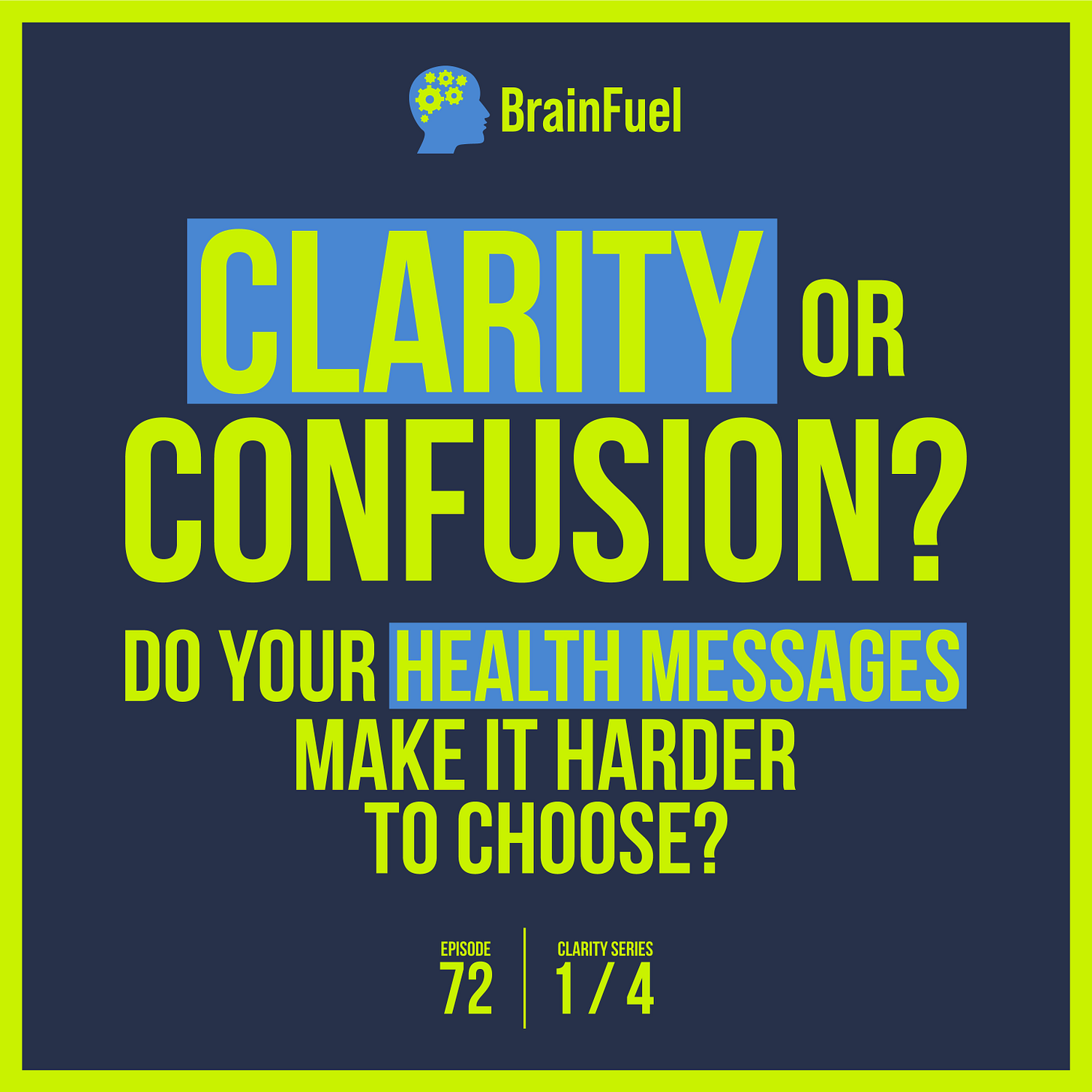Do we offer clarity or confusion?
Do your health messages make it harder to choose? Is 'Choice Architecture' a solution? (Audio: BrainFuel Breather for reset and clarity.)
Welcome.
This episode is the first of four exploring ‘Clarity’ in health decisions. It teases out the core learning from E72 of the BrainFuel Podcast (See below for Spotify links). The audio above is a gift. It is your BrainFuel Breather for your reset and clarity.
You know that moment when you’re so overwhelmed you can’t remember what you were doing?
That moment your brain feels at full capacity.
Chances are your audience feels like that too - a lot of the time - probably when engaging with your services and campaigns.
So here’s the question:
Are we helping or adding to the chaos?
Do we offer clarity or confusion?
Do your health messages make it easier to choose?
Because the effectiveness of your work in health communications, service design, or team leadership is directly linked to how clear you are when making decisions.
Behavioural science shows us that human decision-making isn’t all that unique.
We’re not entirely rational and we don’t have to be. Yet we often judge decisions based on how ‘logical’ they are.
We still tend to believe that a better decision is a more rational one.
Working in health, this filter shows up all the time.
I’ve spent years in rooms with clinicians, service leads planning health services and prevention campaigns to help the public make different health decisions. And it is always there under the surface - sometimes loudly, sometimes not - but it’s there: If only people knew the facts, they’d make the ‘right’ choice.
Take A&E (Accident and Emergency) departments in England. For over two decades, public health campaigns have tried to reduce the number of non-urgent or non-emergency visits.
The message?
‘Make the right choice.’ ‘Choose well.’ ‘Think before you come.’
These are logical asks.
But when someone’s in pain, scared, unsure? Logic doesn’t lead.
People default to what feels safe and fast. Mental shortcuts kick in. And yet we still speak to them as if they’re calm, logical, and planning ahead.
Spoiler: they’re not.
So how does taking a behaviour change approach help?
When looking through a behavioural lens it is essential you begin with the understanding that we’re not here to ‘fix’ the behaviour.
We’re here to understand it—and then design around it.
When you do this you start with empathy and open up to the culture, systems and social norms influencing the decisions. Because if we don’t take into account what people are actually experiencing, we’re at danger of just layering noise onto a noisy world.
The world is noisier than ever and we have to understand how that is affecting how people make health decisions.
For fun let’s compare back in 2002 when I was a 27 year-old health comms lead living a fun single life in London and compare distractions and noise levels to now - 2025. (I’m now a 50 year-old mum of two, leading behaviour change in health.)
Back in 2002, we had flip phones, dial-up internet; but no Facebook, no YouTube, no iPhone. Communication was limited to TV, newspapers, and in-person channels.
The Blackberry was used for messaging only (no camera, no social, no web.)
And gloriously we have the infamous sitcom Friends!
Your brain wasn’t constantly pulled in 100 directions.
Now lets fast forward to 2025.
We still have Friends (courtesy of Netflix), but studies claim (including Ofcom) that we can spend up to 6 hours online every day across multiple channels.
According to a UC San Diego study, we consume 34GB of information a day.
That’s over 100,000 words.
The equivalent of 16 movies.
A million images.
But.
Our brains haven’t changed. The processor’s the same.
But now the input is relentless.
Social media is designed to tug at our brains, to keep people coming back. And so are so many of our health apps.
But do you ask - are we designing for this reality or are we Are we designing for that reality? Or are we just adding to the chaos, do we cause confusion or clarity.
Because if your message relies on a calm, rational audience - good luck.
Lets look at our brain:
The prefrontal cortex is behind your forehead and it is like the boss. It helps you focus, plan, regulate emotions, and make good decisions. But it only has so much bandwidth. When the inputs keep coming - emails, videos, messages -this part of your brain gets overwhelmed. It checks out. You lose focus, snap easily, forget things. (Sound familiar?)
When that happens, the amygdala - the brain’s alarm bell - takes over. It doesn’t analyse. It just reacts. Fight, flight, freeze. Lots of your mental shortcuts - your behavioural biases kick in.
And the hippocampus (the bit that organises new information) can’t process the sheer volume. Think of it like trying to save 100 photos at once on a phone with no storage.
So now your audience is stressed, distracted, and forgetful.
And still, we expect them to remember health campaign messaging and choose well and act calmly.
But what can we do?
One idea is to use ‘choice architecture’.
‘Choice architecture’ is a term to describe the action of focusing on the way we design choices.
The idea was first introduced by Richard Thaler and Cass Sunstein in their 2008 book 'Nudge: Improving Decisions About Health, Wealth, and Happiness.' And it provokes a lot of commentary on whose to say what the better choice is.
But.
Here’s the kicker.
If you are designing health information, emails, texts, billboards, newsletter, waiting room information, patient literature you are using choice architecture where you know it or not.
The question is - who and what are you designing for? Are you making it harder or simpler?
A recent study in the Journal of Medical Internet Research called ‘Click & Crunch High Schools’, by Foster et al. (2024) examined choice architecture interventions in Australian school canteens to influence healthy food choices.
This study found that strategies like menu labeling, item positioning, and prompts led to increased selection of healthy items and reduced selection of less healthy ones.
I know…it sounds so obvious doesn’t it???
Make your desired choice the easier choice. But we just don’t do it enough.
It worked because it didn’t add to the mental load. It reduced it.
It’s a good reminder.
When people are overwhelmed, they don’t need more choices.
They need better ones.
So let’s keep asking: are we making it easier—or just hoping they’ll figure it out?
But this week we opened with you.. so lets check in.
How overloaded are you?
Because we all live in this noisy world too - alongside our audiences.
Are you jumping from zoom call to zoom call?
Has all your deep work, thinking time, writing, visioning work being scheduled out of the calendar?
If this reasonates we must ask ourselves…
‘how stressed am I when I am planning for my audiences? Am I listening with empathy or am I trying to fix a problem?’
Because the truth is that we may work on change, lead change but we also struggle to make changes ourselves. We wrestle with the same overloads and biases our audiences do.
That’s why we have a special treat for everyone.
Introducing BrainFuel Breathers - a dose of brain fuel - an invite for you to reset and renew.
Every month every paid Subscriber gets their invite to the private podcast hosting their breathwork audio guide.
Guided breath work to help you reset between zoom calls, refresh before pitches and get clarity before making big decisions. (Perfect for doing at work. You just listen and breath. That’s it. No experience needed!)
And to celebrate our shift to Substack this July we are releasing three short BrainFuel Breathers to help you get started for all subscribers.
July’s theme is Clarity - designed to help you come back from chaos and return to clarity.
It can be used between zoom meetings, sitting in the car or on the commute.
It’s led by the incredible Sabine a breathwork facilitator and yoga teacher she has designed 3 short introductory Breathers and one guided Stress Release espeically for people working in change and leading change.
Think of it like permission to pause and breathe and connect back to you.
Because chances are if you work in the health space, you’re here to help - so let’s make sure you’re looked after too!
Plus
Paid subscribers get the Change Cards too!
We’ve been testing these cards in the Behaviour Change Marketing Bootcamp training and they’ve proved so popular we wanted to make them accessible to everyone in any easy way.
The Change Cards are a tool you can use in your work. Build your deck of cards to build your deck of behavioural science tactics so you can increase your impact.
Change Card 001- Clarity & Choice Architecture
(Your Overloaded Audience)
Insight:
Your audience is overloaded -just like you. When your health comms adds to mental noise, it blocks action instead of inspiring it.Behavioural Science:
When the prefrontal cortex is overwhelmed, decision-making shifts from thoughtful reasoning to reactive bias. In this state, clarity beats logic. Plan for your messaging to fail.Try This
Use choice architecture to reduce overwhelm. Remove choices and distractions, spotlight the easiest next step, and test what feels frictionless.
Reflection Question:
Are you designing for a calm, rational audience - or for the messy, distracted reality they (and you) live in?
Thanks for reading. This week is a long one and moving forward if you would like the Change Card and BrainFuel and deeper reflection please consider subscribing and support this work. Think of it like a permission slip so you can reset and fuel your brain too!
Don’t forget to check out the Podcast too.








